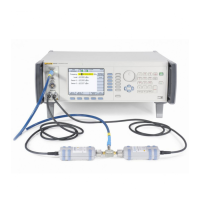Performance Tests
Performance Test 3
3-47
Note
The above procedure and test points listed in Tables 3-18 and 3-19
verify the performance of all the level control and attenuation circuits
that determine level accuracy throughout the entire amplitude range,
avoiding the need to make difficult precision level measurements at
extremely low levels below -101 dBm. However, the following
optional ultra-low-level measurement procedure is provided for users
choosing to verify the lower level outputs directly.
Ultra-Low Level Test Points (steps 27-34)
If required, use the following optional procedure to verify the absolute level
accuracy of the UUT below -101 dBm.
Note
Ultra-low-level measurements are made relative to levels previously
measured with the Measuring Receiver. Two levels (-81 dBm and
-91 dBm) are used as reference points to provide the required UUT
hardware configurations for the subsequent tests. The value of the
output level at -81 dBm and -91 dBm measured in steps 30 through
37 above will be used as references in the following procedure,
identified as P
-81
and P
-91
respectively for each test frequency. It is
important that the correct sequence is followed as described.
Making these precision ultra-low-level measurements requires
appropriate choice of Measuring Receiver settings to provide
adequate linearity, noise floor, and reading repeatability throughout
the amplitude range required. For any given frequency the
Measuring Receiver the settings must be maintained for all
amplitudes at that frequency after establishing the reference point. In
particular, receiver attenuator, reference level, and resolution
bandwidth settings must not change.
27. On the UUT enable the REF FREQUENCY OUTPUT at 10 MHz and set the
UUT as follows:
Frequency 10 MHz
Level -81 dBm
Output OPER
28. Allow the Measuring Receiver to tune the input signal, and then set the
controls to measure RF level, relative (dB) to the current input level.
29. Without changing any Measuring Receiver settings, set the UUT to the next
amplitude listed in Table 3-21 for this frequency. Allow the Measuring
Receiver reading to stabilize and record the reading as P
rel
. (Note that P
rel
will
be a negative number in dB).
30. Calculate the UUT output P
out
= P
-81
+ P
rel
. Check that the value of P
out
is
within the tolerance shown in part A of Table 3-21.
31. Repeat steps 30 and 31 for each amplitude listed in part A of Table 3-21 for
this frequency.

